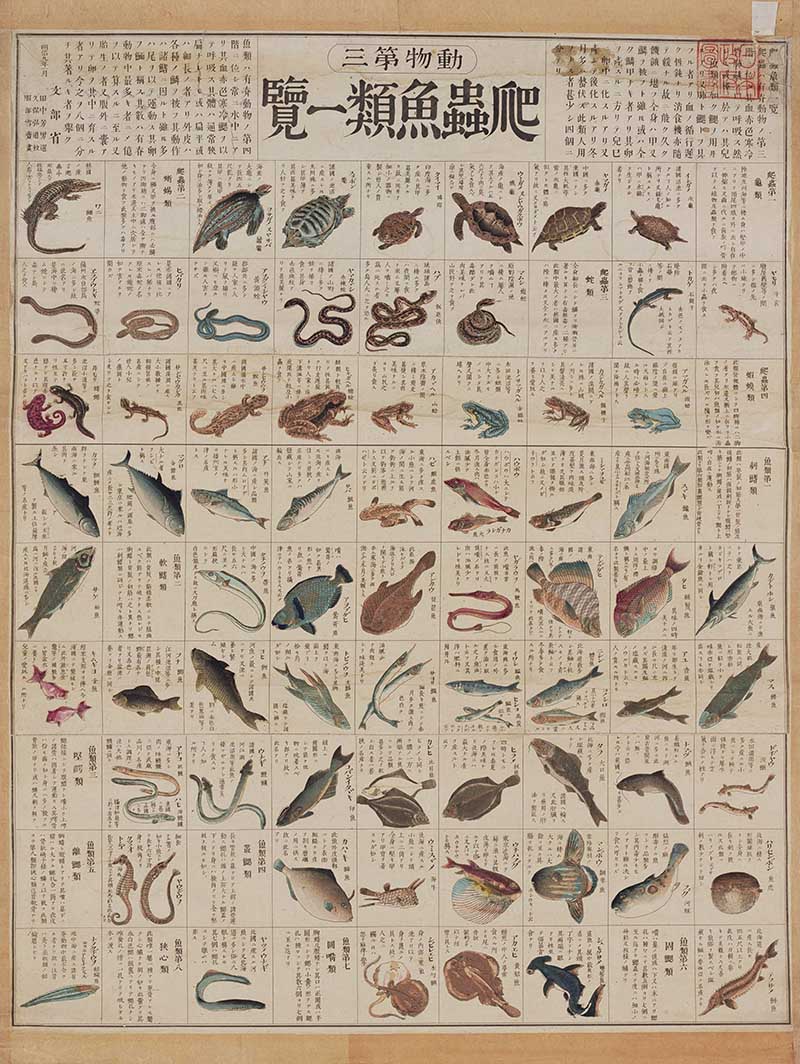Add timeless charm to your projects with free downloadable Japanese nature charts. These 19th-century botanical and zoological woodblocks are public domain and ideal for art lovers, crafters, and educators.
If you’ve ever fallen down the rabbit hole of vintage Japanese prints (guilty!), you’ll understand the joy of discovering a new artist whose work makes you stop and say, “Ooh, that’s lovely.” That’s exactly how I felt when I stumbled across the Chart of Plants and Natural History Map illustrations from 1873.
I’ve already shared several gorgeous Japanese nature collections on Picturebox Blue—like the seashell prints, the Japanese Zodiac Animals by Takeuchi Seihō, and those lovely fish woodblock prints with that soft, aged colour palette. But these nature charts? They’re something special.
They feel like a gentle nature walk with a sketchbook in hand—except it’s the 19th century, and the sketchbook has turned into delicate woodblock prints of vegetables, fruits, fish, and fascinating creatures. You’d want these things framed in a cosy kitchen or used in a nature-themed craft project.
Lucky for us, these prints are now in the public domain. I found eight of them—four from the Chart of Plants and four from the Natural History Chart series—and turned them into high-resolution downloads for you to enjoy.
The prints remind me of Adolphe Millot’s natural history posters—they have the same visual catalogue style but a quieter, more minimal aesthetic typical of Japanese design from the period.
A Quick Look at the Collection
The Chart of Plants was originally published by Japan’s Ministry of Education in 1873. These charts were designed to be used in classrooms, combining scientific accuracy with gorgeous woodblock artistry. You’ll find:
- Plump persimmons and twisting gourds
- Fragrant herbs and edible seaweed
- Rice grains and flowering stalks
- Lovely calligraphy, and in some cases, English annotations!
The prints were illustrated by multiple artists, including Kato Chikusai and Hasegawa Chikuyo, each with their elegant style. The visual catalogue makes you want to press flowers or label your spice jars.
But it doesn’t stop there: The Natural History Charts from the same year are just as charming—maybe even more so. They’re educational, a bit whimsical, and full of vintage character.
Download the Free Prints
I’ve carefully cleaned up and enhanced eight of these illustrations (four plant charts and four animal maps), and you can download them as high-res JPEGS—perfect for printing, crafting, or just admiring up close. Just click on the title above the chart you want, and a higher-resolution image will open in a new window to print or save.
Whether you’re into Japanese art, natural history, or vintage ephemera, these make a lovely addition to your digital collection—or your walls.
Chart of Plants 1
Painted by Kato Chikusai (born in Tokyo, real name Tokushin). An Apprentice of Kato Koshin, he taught at Tokyo Imperial University and painted several plant illustrations. In “The Introduction to Botany,” he drew the leaves and roots of plants and the shape of flowers in multicoloured illustrations.
If you’re looking for more leaf posts, check out these autumn leaf charts or these houseplant leaf prints.

Chart of Plants 2
Painted by Hasegawa Chikuyo. The gourd flower family are divided into groups. Fruits such as peach, plum, and persimmon are drawn in the upper section, and pumpkin, eggplant, and gourd are drawn in the lower section, both with multicoloured paints.
Check out Adolphe Millot’s Fruit and Vegetable charts, Charlotte Young’s vegetables, and these exquisite Asian fruit watercolours.

Chart of Plants 3
This page was painted by Hasegawa Chikuyo. It is divided into three groups: corn, peas, and root plants, and they are painted in multi-colour. Among the crops are rice, wheat, millet, and maise.
Check out these botanical charts from Oken’s Natural History.

Chart of Plants 4
Painted by Hasegawa Chikuyo, the page is divided into four sections: plants with leaves and stems, those with a strong smell or hot taste, seaweeds, and mushrooms. Spices such as garlic are illustrated as examples of plants with a strong smell, and wasabi is for those with a hot taste.
Check out these other vintage mushroom charts and seaweed prints on the site.

Japanese Animal Chart
A Japanese educational wall chart of mammals.
Check out the Larousse Animal Charts on the blog and Jardine’s Animals.

Animal Chart 2 Birds
The bird chart features several Japanese bird species, each illustrated in a simple, straightforward style typical of 19th-century woodblock prints.
For more beautiful Japanese bird prints, check out those of Ohara Koson.

Animal Chart 3: Reptiles and Fish
Vintage Japanese educational animal chart featuring reptiles, amphibians and fish.
Check out Louis Renard’s fantastical fish and this collection of vintage frog illustrations.

Animal Chart 4 Sealife
A mixture of sealife creatures including crustaceans, molluscs and cnidaria (jellyfish and corals).
Check out Adolphe Millot’s sealife posters and Haeckel’s jellyfish.

A Snapshot of Science, Art, and Curiosity & More To Explore
There’s something special about these Japanese Nature charts. They represent a moment when Japan embraced a new era of learning and creativity. You can see how the country blended traditional techniques with Western-style categorisation and global awareness.
I love that these prints were originally made for the classroom—meant to be seen, touched, and learned from. Now, centuries later, they’re here for us to enjoy as art.
Here, you’ll find the site’s entire collection of vintage educational posters and many more vintage Japanese-themed prints.
Pin for later

If you fancy, you can Buy Me A Coffee Here.
